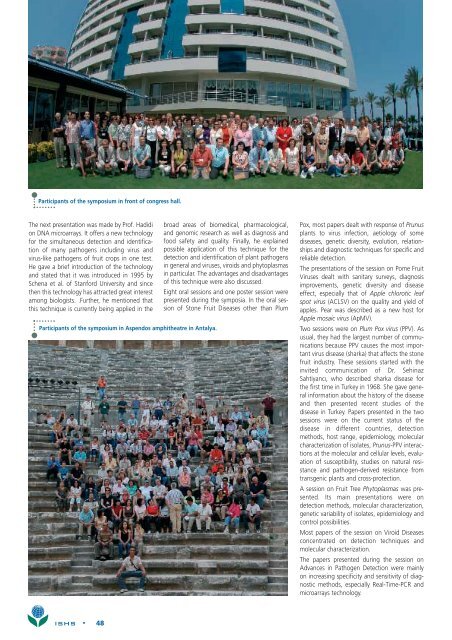Chronica - Acta Horticulturae
Chronica - Acta Horticulturae
Chronica - Acta Horticulturae
Create successful ePaper yourself
Turn your PDF publications into a flip-book with our unique Google optimized e-Paper software.
Participants of the symposium in front of congress hall.<br />
The next presentation was made by Prof. Hadidi<br />
on DNA microarrays. It offers a new technology<br />
for the simultaneous detection and identification<br />
of many pathogens including virus and<br />
virus-like pathogens of fruit crops in one test.<br />
He gave a brief introduction of the technology<br />
and stated that it was introduced in 1995 by<br />
Schena et al. of Stanford University and since<br />
then this technology has attracted great interest<br />
among biologists. .Further, he mentioned that<br />
this technique is currently being applied in the<br />
Participants of the symposium in Aspendos amphitheatre in Antalya.<br />
broad areas of biomedical, pharmacological,<br />
and genomic research as well as diagnosis and<br />
food safety and quality. Finally, he explained<br />
possible application of this technique for the<br />
detection and identification of plant pathogens<br />
in general and viruses, viroids and phytoplasmas<br />
in particular. The advantages and disadvantages<br />
of this technique were also discussed.<br />
Eight oral sessions and one poster session were<br />
presented during the symposia. In the oral session<br />
of Stone Fruit Diseases other than Plum<br />
Pox, most papers dealt with response of Prunus<br />
plants to virus infection, aetiology of some<br />
diseases, genetic diversity, evolution, relationships<br />
and diagnostic techniques for specific and<br />
reliable detection.<br />
The presentations of the session on Pome Fruit<br />
Viruses dealt with sanitary surveys, diagnosis<br />
improvements, genetic diversity and disease<br />
effect, especially that of Apple chlorotic leaf<br />
spot virus (ACLSV) on the quality and yield of<br />
apples. Pear was described as a new host for<br />
Apple mosaic virus (ApMV).<br />
Two sessions were on Plum Pox virus (PPV). As<br />
usual, they had the largest number of communications<br />
because PPV causes the most important<br />
virus disease (sharka) that affects the stone<br />
fruit industry. These sessions started with the<br />
invited communication of Dr. Sehinaz<br />
Sahtiyancı, who described sharka disease for<br />
the first time in Turkey in 1968. She gave general<br />
information about the history of the disease<br />
and then presented recent studies of the<br />
disease in Turkey. Papers presented in the two<br />
sessions were on the current status of the<br />
disease in different countries, detection<br />
methods, host range, epidemiology, molecular<br />
characterization of isolates, Prunus-PPV interactions<br />
at the molecular and cellular levels, evaluation<br />
of susceptibility, studies on natural resistance<br />
and pathogen-derived resistance from<br />
transgenic plants and cross-protection.<br />
A session on Fruit Tree Phytoplasmas was presented.<br />
Its main presentations were on<br />
detection methods, molecular characterization,<br />
genetic variability of isolates, epidemiology and<br />
control possibilities.<br />
Most papers of the session on Viroid Diseases<br />
concentrated on detection techniques and<br />
molecular characterization.<br />
The papers presented during the session on<br />
Advances in Pathogen Detection were mainly<br />
on increasing specificity and sensitivity of diagnostic<br />
methods, especially Real-Time-PCR and<br />
microarrays technology.<br />
ISHS • 48
















